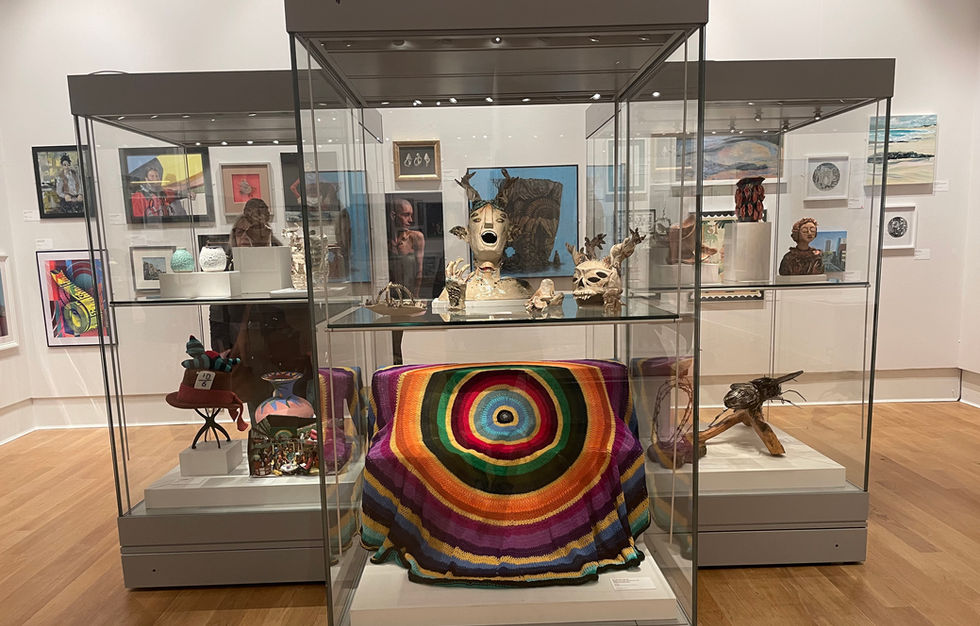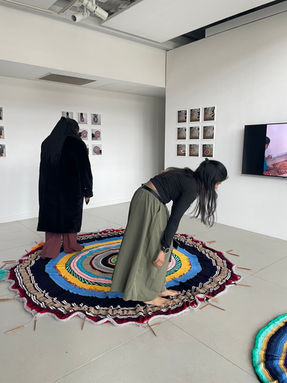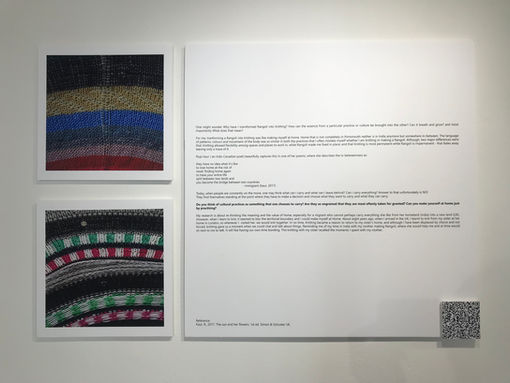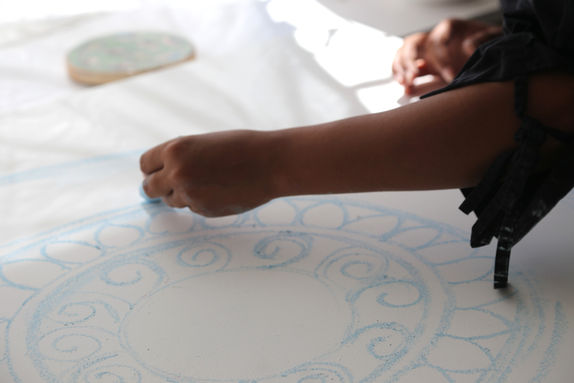top of page
Knitted Skies June 2025
Knitted Skies emerged as an extension to my PhD research on 'home and home-making practices. To continue my argument that when migrants leave their home in homeland, they carry intangible habits, rituals, beliefs, values, morals, practices, and so on that have the power to become an agency to help build a home for the migrant in a foreign place. This exhibition took place during Riverside Festival Leicester 2025, supported by Leicester City Council and De Montfort University. To give voice to my argument, I called for students, members of DMU staff, Administration services to knit a patch that in some way or the other reminds them of their 'home' - the home that they had left behind.
To support the knitters, I also taught non-knitters 'how to knit' through De Montfort University's Community week. Hereby, I controlled the yarn colour, and yarn type to resemble the society/policies that others enforce on us as a migrant, and we still try to belong to this new place. This control of materials were also decisive to see whether individuals remain within the given constraint or do they challenge and add new colour/yarn for their comfort? I allowed enough time for volunteer knitters to come forward to collect their preferred yarn from a small selection of yarn that I had already acquired. Once they collected the yarn, they had about 4-6 weeks to submit a 45cm X 50cm knitted patch.
The submission validated my understanding, when knitters submitted their work, very few went with the required dimensions; while the others went on their own and did different sizes. Within those received patches, one of the patch was circle-shaped - the knitter knitted different slices of the circle and attached it all to form a neat circle. Through enquiring why she did a circle? She responded back with "This is how my grandmother knitted her own rug about 100 years ago. I used to see this rug whenever I visited my grandmother's house with my mother. After she passed, the rug was brought to my mother's house and a few years ago, the rug was spoiled and we had to part ways with it. But when you mentioned about 'Home', I could immediately see that rug and hence attempted to knit a replica of it." While she made a replica of her grandmother's knitted rug, one of the other knitter actually crocheted a house with some of their possessions.

‘Silence still governs our consciousness’ Dec 2024 - Jan 2025
My artwork was selected to be displayed at The Open: The People's Exhibition 2024 – Group show (featuring over 200+ artists and makers), an annual exhibition at Leicester Museum & Art Gallery, celebrating the creative talent of Leicester and the East Midlands |14th December 2024 – 31st January 2025. Video
'Knitting (a)way Home: blurring the boundaries Oct - Nov 2024
Knitting (a)way Home: blurring the boundaries was selected to be a part of 'Spirit to Matter: Alchemy in the Making' exhibition. Artists Pasha Kincaid, Marianne Scahill-Pape, Raisa Watkiss and Shivani Khoshia along with selected local artists, exhibited a myriad of artworks that explore creativity as an alchemical process – art channelling ideas into form; art manifesting stories into culture; and reflecting the divine in humanity.
My work reflect how 'Home' is such a universal concept that it is increasingly being problematized, as its meaning, how it is constituted and how it relates to other walks of life changes depending upon who is questioning it. Talking from a migrant's perspective, leaving one's home in their motherland and finding another home in the new place seems rational and easy as all they have to do is choose between what they want to bring with them and what they want to leave behind. However, as time passes, some of those migrants feel out of place and do not recognize who they have become - creating a place of confusion, frustration and anger. My practice-based PhD focused on this particular issue and developed a new way of creating an 'in-between home' by transferring knowledge from one cultural practice into another. I, as a migrant brought the knowledge of making Rangolis (a cultural practice, that I use to perform back in India during Diwali Festival) into Knitting (a cultural practice - where I live now) to create a circle shaped knitted artefact called 'Home'. I see ‘Home’ as a tangible Rangoli that can be unfolded on the floor (similar to how I would make Rangolis back in my homeland) and folded back up to clear the floor (referring to the constant moving). As I constantly move between places within the UK, I believe my project 'Home' will still be on-going until I settle for good.

Group exhibition - ShrineShare & 'RangKnit' May 2024
ShrineShare & RangKnit is a collection of drawn works by six UK and ten Malaysian artists to share their visions of sacred shrines - be they ancient, personal, or imagined. From an arcade cabinet to a lonely rock cairn to a collection of talismanic artefacts from artist's studio. Whilst, RangKnit reminds a migrant of their left home and demonstrates how a migrant can re-built a sense of their lost home in the host country/new place. 'RangKnit' coalesces two cultural practices: Rangoli and Knitting, developed through a practice-based Ph.D. The shows are curated by artist David Blandy, Malaysian based artist Sharon Chin, writer Zedeck Siew, and Dr Pooja Shah.
The exhibition is displayed at Leicester Art Gallery, at Vijay Patel Building Leicester. It is open from 23rd May - 12th June 2024. It is the first time that I displayed 'RangKnit', allowing the members of public to interact with the artwork, building new conversations, gestures, memories, movements, and relationships with the work. It also coincided with the Riverside Festival 2024, enabling adults, kids and even pets to interact and play on the artwork. New dialogues between home, migration, interiors and perspective on art emerged. It was successful show, making new connections and new branches for 'RangKnit' to grow, creating new communities and making a new home for myself.
First solo exhibition - 'RangKnit' Aug 2022
Pooja Shah is a PhD student at the School of Architecture, Faculty of Creative and Cultural Industries at Portsmouth University & ‘RangKnit’ is a solo show of works created during a practice-based doctoral research journey at the University of Portsmouth. ‘RangKnit’ marks a continuation of the artist’s interest in Rangoli, which has formed a pivotal part of her practice over the past three years as she has explored how her attachments with home (family), activities that are performed inside the home and her relationship with the interiors shift with the shift in cultural context. 'RangKnit' is fully funded by the University of Portsmouth and the Jack House Gallery.
Pooja knits intricate patterns seen in Indian Textiles using yarns and knitting needles. Lying somewhere between contemporary knitting practices and Interior design, these circles, concentric compositions create a complex world recording different movements of body, conversations and experiences. Her fascination with knitting dates back to 2013, when she first learnt to knit scarfs for herself and for her friends as a farewell present. When she began her PhD, she explored the history of knitting in the UK and Portsmouth –a practice that revealed an organic transition from making for self/family to building surfaces that can allow an interaction/conversation with others. Drawing from a variety of cultural and societal influences, she uses different yarns, colour and pattern palettes.
The main argument that Pooja attempts to make through her work is that ‘Home’ is not a mere place/space/feeling that is left behind –when a migrant travel far away from her/his homeland either temporarily or permanently, rather home can become a ‘practice’ that is continued into a different mode. In other words, she demonstrates how the knowledge she had gained through making Rangoli (at her homeland while growing up) can be transmitted and transformed into knitting (a traditionally western practice) so that she can feel at home in the UK.
Having worked at Jacob Hashimoto studio, a New York based artist, who shares half- Japanese and half-Irish roots, she learnt a great deal on how to fuse two different cultures together (asking questions such as: what happens when one culture overshadows the other and how/where can an element from a particular culture be left loose in order for it to breath and grow).
bottom of page

























































